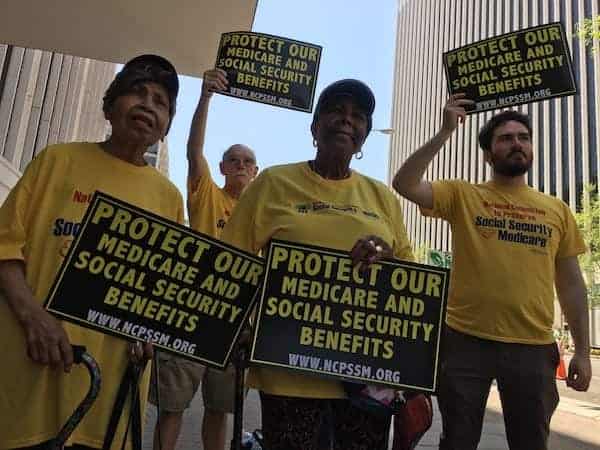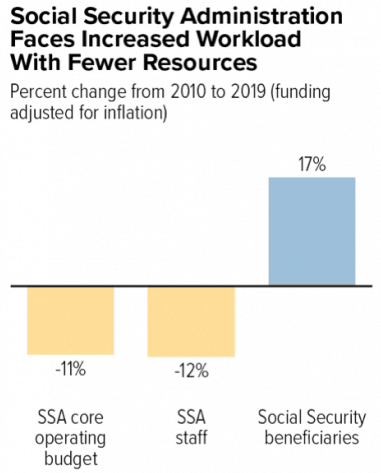
National Committee volunteers protest the closing of an SSA field office in Arlington, Virginia in 2018
While it’s laudable that Congress reached a 2020 spending deal in time to avert a government shutdown, the news wasn’t great for those who rely on the Social Security Administration (SSA), which basically means almost every American senior. Monday’s $1.4 trillion agreement – which does increase spending on other programs for older Americans – gives SSA only a small bump in its operating budget. The $99 million increase (less than 1%) over 2019 funding levels does not even keep pace with inflation, and perpetuates the decade-long divestment in crucial customer service functions for Social Security’s 69 million beneficiaries. The agency has been chronically underfunded at a time when 10,000 Americans turn 65 every day.
The divestment began at the start of this decade, coinciding with the Republican take-over of the House and the ascendancy of the Tea Party. Congress slashed SSA’s operating budget 11% (adjusted for inflation) between fiscal years 2010 and 2019. Left to fend for itself with a growing customer base and reduced resources, the SSA began closing field offices and furloughing employees. Customer service suffered and seniors – especially those of modest means – paid the price in the form of increased wait times to talk to an SSA representative and long delays in disability hearings during which thousands of claimants died before their appeals could be adjudicated.
As Mark Miller reported for Reuters last June:
“[Nearly one million] people were waiting for appeals hearings before administrative law judges on disability benefit applications in fiscal 2018. In the same year, the average wait time for callers to the Social Security toll-free number was 24 minutes, up from 13.6 minutes in fiscal 2016 – and 15% of callers received a busy signal. Social Security’s processing centers, which handle claims after beneficiaries are determined to be eligible, faced an enormous backlog of 2.9 million cases this year.” – Mark Miller, Reuters, 6/5/19
After years of cuts, Congress increased SSA’s operating budget by 2% for FY 2018. But the agency’s FY 2019 budget was cut by 2%, leaving SSA financially treading water. SSA’s former acting director, Nancy Berryhill, had requested a healthy $500 million increase for 2020. The Democratic-controlled House was poised to offer a $300 million (or roughly 3%) bump. Unfortunately, the Senate and President Trump sought a zero increase for SSA, producing a House-Senate compromise of only $99 million.
The main culprits are automatic caps that were imposed on discretionary federal spending beginning in 2011. Recent Congresses have adjusted those caps to allow more spending, but SSA’s budgets have continued to languish. This is especially egregious because SSA operations are funded by workers’ Social Security payroll contributions, and should not be lumped in with discretionary spending and subject to arbitrary caps and cuts. Seniors have earned their benefits and expect them to be administered with minimal time, trouble, and pain.

Source: Center for Budget and Policy Priorities
Earlier this year, a bipartisan three-person commission recommended exempting SSA’s operating budget from automatic spending caps. Meanwhile, Rep. John Larson’s Social Security 2100 Act would require that SSA’s administrative budget be fixed at 1.5% of total benefits paid. For 2020, that would translate to a $15 billion budget compared to the actual $11 billion just approved by Congress – or 36% more under Larson’s formula. That would go a long way toward restoring the level of customer service that beneficiaries truly need and expect.


